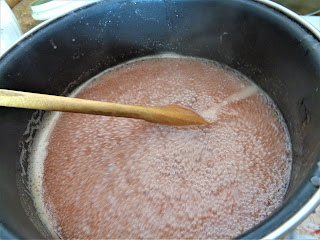Quince are always in season when we arrive. I have two decent recipes for Lamb tajine with quince and when we went to Riad Hida the salad there contained some plain cooked quince "just boiled in water,or if you have some good honey you can add some". In Wales if you mention quince people always associate it with jelly so I looked on the internet. There were lots of recipes for quince jelly, mostly american and also for membrillo a sort of quince paste the Iberians eat with cheese. One site by an american moroccan gave 20 recipes that were all sweet, no tajines.
We have no visitors coming this autumn to cook for and I had found a packet of butter muslin lurking unused in a kitchen drawer so I decided to to make jelly and membrillo as a project.
First we had to buy a jam pan, for the princely sum of £8. Quinces are very high in pectin which is why they are used for jellies or added to jams, but the skin and cores have particularly high concentrations. If you are just making jelly you can just roughly chop your quinces and place in the pan skin, core and all, but as I also wanted to make membrillo i needed to separate the flesh and carefully peeled and cored my 14 quinces to put the discard into the butter muslin. Quinces are the devil's fruit to peel as they are irregular and hard so it was a major chore.I could then boil them to extract the pectin whilst keeping the flesh unsullied.
None of my recipes had been particular about how much liquid one should have from how many fruit. Some said that if you hadn't enough liquid add boiling water to the pulp and re-drain but didn't enumerate "enough". I had been worried about having too much as we did not have many jam jars and could only sterilise 4 at a time in the oven but I was quite surprised to find there were only two and a half cups. Never the less I added an equal volume of sugar and boiled it up to a good rolling boil until the mixture wrinkled when pored onto a chilled plate an pushed.
I filled two jars and a bit of one and admired the dark rich colour which was darker than the jelly pictures on the internet, more the colour of membrillo.
I left everything to set overnight.
Next day I set about making the membrillo. I measured the pulp and added three-quarters the volume of sugar and heated it in a pan.
You have to stir a lot to stop it burning and it gradually goes darker , aiming at the colour my jars of jelly had turned out. After a while my arm ached. The recipe indicated that it was done when it all stuck together in a goop. I had been doing that for some time although the colour was somewhat lighter than expected. I turned it into a dish and left it to set overnight.
I turned it out the next day. It wasn't as set as I expected, definately a paste but would cut into pieces to wrap in cling film for storage.
I thought I'd try a bit. The tang element of the fruit taste had gone and really it was just very very sugary. The idea is that it is eaten with cheese but really it wasn't a pinch on Mrs Bridges Port Wine Jelly which would be the alternative. I thought I'd better try the jelly. I opened the part filled jar which I knew wouldn't keep long. I was wrong. It would keep for ever. It was like concrete. The only way to extract the contents would be to use a pneumatic drill.
Only one thing for it.
Next day I set about making the membrillo. I measured the pulp and added three-quarters the volume of sugar and heated it in a pan.
You have to stir a lot to stop it burning and it gradually goes darker , aiming at the colour my jars of jelly had turned out. After a while my arm ached. The recipe indicated that it was done when it all stuck together in a goop. I had been doing that for some time although the colour was somewhat lighter than expected. I turned it into a dish and left it to set overnight.
I turned it out the next day. It wasn't as set as I expected, definately a paste but would cut into pieces to wrap in cling film for storage.
I thought I'd try a bit. The tang element of the fruit taste had gone and really it was just very very sugary. The idea is that it is eaten with cheese but really it wasn't a pinch on Mrs Bridges Port Wine Jelly which would be the alternative. I thought I'd better try the jelly. I opened the part filled jar which I knew wouldn't keep long. I was wrong. It would keep for ever. It was like concrete. The only way to extract the contents would be to use a pneumatic drill.
Only one thing for it.










No comments:
Post a Comment